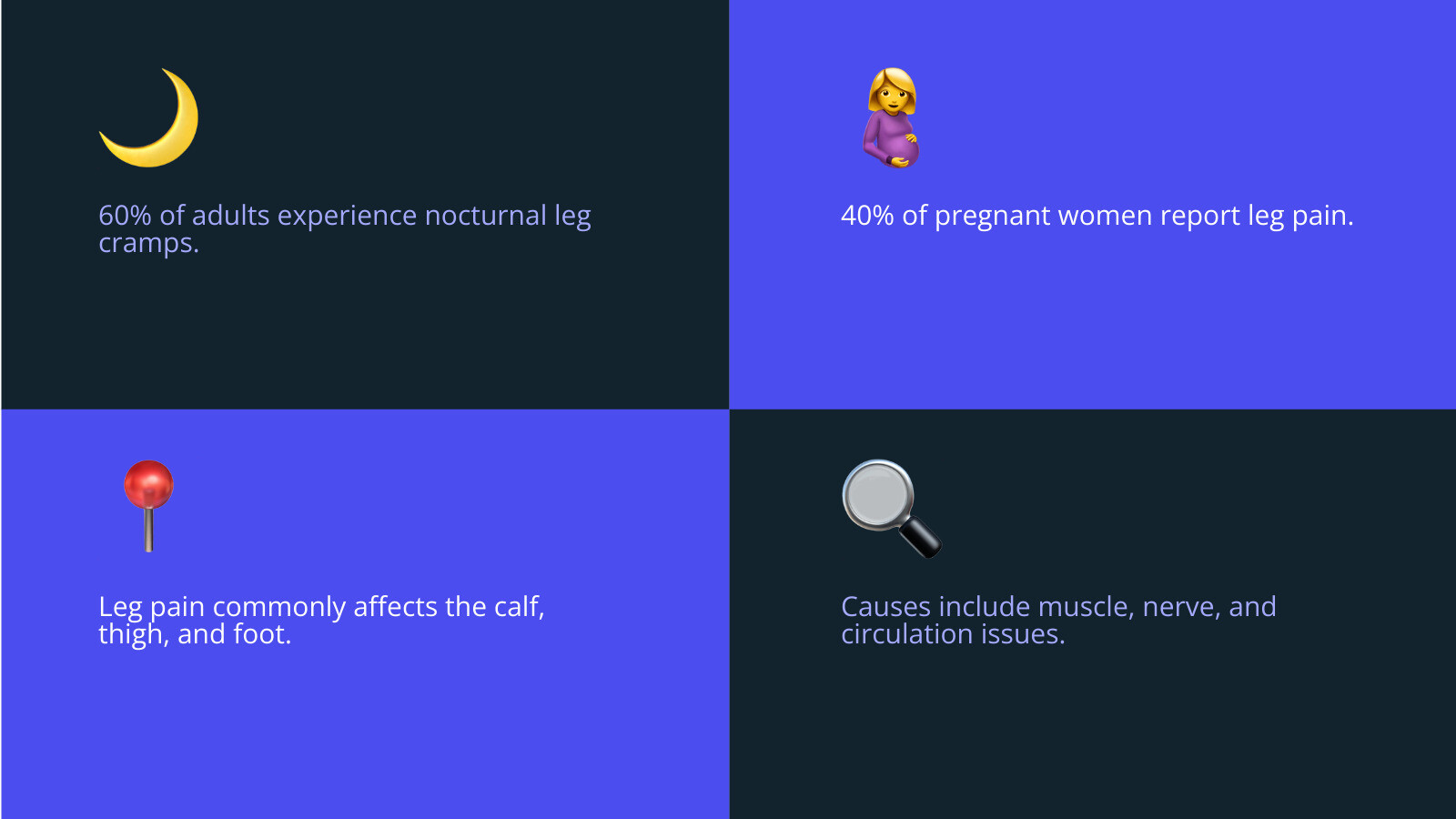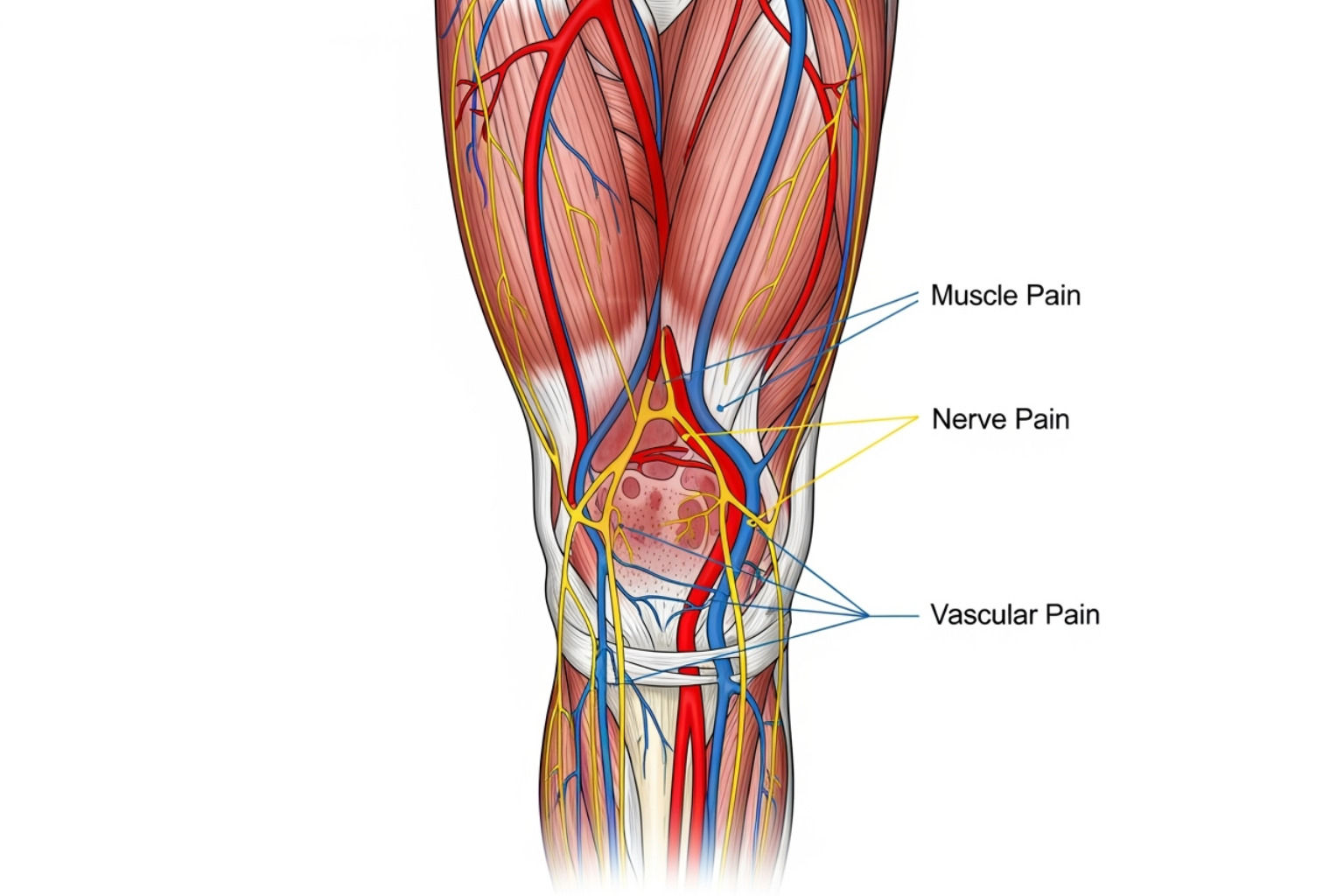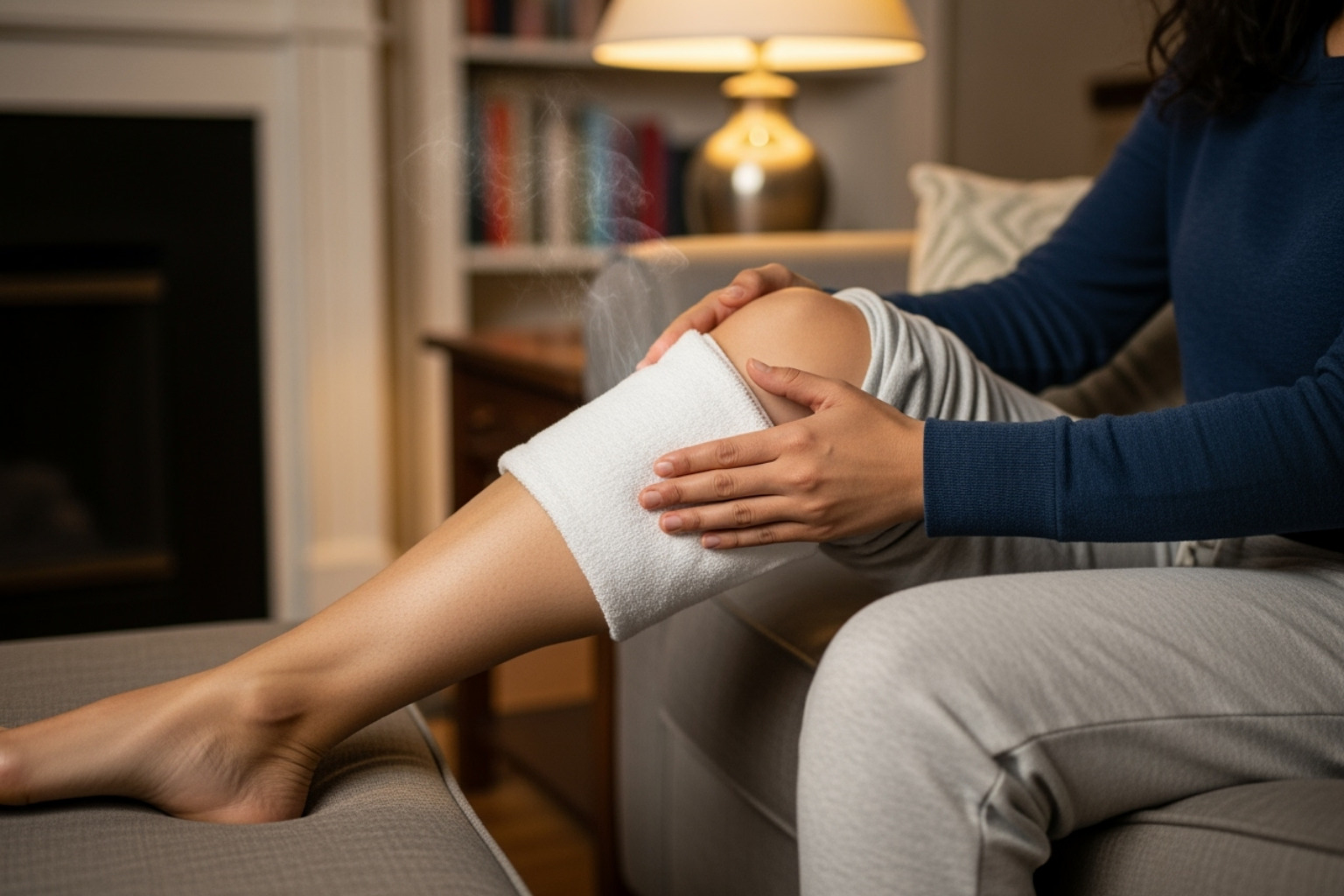Why Leg Pain Affects So Many People
Up to 60% of adults seek pain relief for legs due to uncomfortable nighttime cramps. Whether it's a sudden spasm, a persistent ache, or sharp pain, finding fast, effective relief is a top priority.
Quick Solutions for Immediate Leg Pain Relief:
- Stretch: Straighten your leg and flex your foot toward your shin.
- Temperature Therapy: Use heat for tightness or cold for swelling.
- Massage: Gentle pressure improves circulation and eases tension.
- Topical Relief: Creams with menthol, aloe, and urea offer targeted comfort.
- Hydrate: Drink water and replenish electrolytes to prevent cramps.
- Lift: Raise your leg above heart level to reduce swelling.
Leg pain has many sources, from muscle cramps and overuse to nerve issues like sciatica and poor circulation. Most cases occur at night, disrupting sleep with pain ranging from a dull ache to severe spasms. Fortunately, most leg pain responds well to simple at-home strategies. Understanding the cause is the first step toward lasting relief.
I'm Tony Enrico, and at Neuropasil, I've helped countless people find effective pain relief for legs with natural, fast-acting solutions. Our formula combines menthol, aloe, and urea to provide the targeted comfort you need to stay active.

Understanding Why Your Legs Hurt: Common Causes and Types
Leg pain appears in many forms—sharp, dull, burning, or tingling. Understanding the source is key to finding effective pain relief for legs. Discomfort can originate from your leg's complex network of bones, muscles, nerves, and blood vessels.

Muscle-Related Pain: Cramps, Strains, and Fatigue
Muscle Pain is the most common type of leg discomfort.
- Muscle cramps are sudden, involuntary contractions, often called "charley horses," that strike the calf, foot, or thigh. They are frequently caused by dehydration, electrolyte imbalances, or muscle overuse.
- Muscle strains occur when muscle fibers overstretch or tear during physical activity, causing sharp pain, tenderness, and swelling. Proper Muscle Strain Treatment begins with rest.
- Muscle fatigue is the heavy, achy feeling after a long day or intense workout. This Muscle Soreness is a sign your muscles are repairing and strengthening.
Nerve-Related Discomfort: Sciatica and Neuropathy
Burning, tingling, numbness, or shooting sensations often point to nerve issues.
- Sciatica occurs when the sciatic nerve is compressed, causing pain to radiate from the lower back down into one leg. The sensation can range from a dull ache to sharp, shooting pains. Understanding Sciatica Pain is crucial for finding relief.
- Neuropathy (nerve damage) causes tingling, numbness, and burning, especially in the feet and lower legs. It affects up to 50% of people with diabetes, but other causes include pinched nerves and infections. If you have these symptoms, learn more about Nerve Pain and Peripheral Neuropathy Symptoms.
Vascular and Circulation Issues
Sometimes, leg pain is a sign of poor blood flow.
- Peripheral Artery Disease (PAD) is the narrowing of arteries, which restricts blood flow. The main symptom is claudication—a cramp-like pain that appears with activity and disappears with rest. Learn more from the American Heart Association's guide on What is Peripheral Artery Disease (PAD)?.
- Deep Vein Thrombosis (DVT) is a serious condition where a blood clot forms in a deep vein. Symptoms include swelling, pain, warmth, and redness in one leg, requiring immediate medical attention.
- Varicose veins are enlarged, twisted veins that cause aching, throbbing, and a heavy feeling in the legs, especially after prolonged standing.
Other Contributing Factors
- Arthritis and Gout: Joint inflammation leads to pain, swelling, and stiffness. Our guide on Managing Arthritis Pain: A Guide to Long-Lasting Relief offers practical strategies.
- Pregnancy: Hormonal changes and increased weight contribute to leg cramps in about 40% of pregnant individuals.
- Medication Side Effects: Some drugs, like statins and diuretics, can cause muscle cramping. Consult your doctor if you suspect this is the cause.
- Prolonged Sitting or Standing: This leads to poor circulation and muscle fatigue.
- Aging: Natural wear and tear make nocturnal leg cramps more common, affecting over a third of people over 60.
Immediate At-Home Strategies for Pain Relief for Legs
When leg pain strikes, you can often find immediate comfort with simple at-home strategies. Knowing what to do in the moment can make all the difference.

The First Steps for a Sudden Leg Cramp
When a muscle seizes, act quickly:
- Stretch: For a calf cramp, straighten your leg and gently pull your toes toward your shin. For a thigh cramp, gently stretch the affected muscle group.
- Massage: Knead the tight muscle to help it relax and improve blood flow.
- Walk it off: Sometimes, simply getting up and walking a few steps can encourage the cramp to release.
Applying Temperature Therapy: Heat vs. Cold
Using the right temperature at the right time is a key part of pain relief for legs.
- Use Heat for muscle tightness, stiffness, or achiness. A warm bath, shower, or heating pad relaxes tense muscles and increases blood flow.
- Use Cold for inflammation, swelling, or a new injury. An ice pack constricts blood vessels, which reduces swelling and numbs the area to ease pain. Apply for 15-20 minutes at a time.
The Cleveland Clinic offers a helpful guide on how to choose between using ice or heat for pain.
Topical Solutions for Targeted Pain Relief for Legs
Topical creams and gels offer direct, targeted comfort right where it hurts.
- Menthol provides a cooling sensation that can override pain signals.
- Aloe and urea soothe and hydrate the skin, helping to deliver active ingredients deeper into the tissue. Aloe is calming, while urea is a powerful moisturizer.
At Neuropasil, we combined these natural ingredients—Aloe, Urea, and Menthol—into a topical cream designed for targeted relief. It's effective for neuropathy, sciatica, muscle soreness, cramps, and joint discomfort, helping athletes and individuals find comfort quickly. Explore our guides on Nerve Pain Relief Creams and Pain Relief Creams for Muscle Pain to learn more.
Safe Use of Over-the-Counter Pain Relief for Legs
Over-the-counter (OTC) pain relievers can offer additional comfort. NSAIDs (like ibuprofen) reduce pain and inflammation, while acetaminophen targets pain without addressing inflammation.
Always follow dosage instructions to avoid potential side effects, such as stomach issues from NSAIDs or liver damage from excess acetaminophen. Consult a healthcare provider before starting any new medication, especially if you have existing health conditions or take other prescriptions. They can help you choose the safest and most effective approach to pain relief for legs.
Long-Term Prevention: Lifestyle Changes for Healthy Legs
While immediate relief is crucial, preventing pain from returning is the ultimate goal. Simple lifestyle changes can build stronger, healthier legs for the long term.

The Role of Diet and Hydration
Proper nutrition and hydration are fundamental for muscle and nerve health.
- Stay Hydrated: Dehydration is a leading cause of muscle cramps. Aim for at least eight glasses of water daily, and more if you're active or in hot weather.
- Balance Electrolytes: Your muscles need potassium, magnesium, sodium, and calcium to function correctly. Eat potassium-rich foods like bananas and sweet potatoes, and magnesium-rich foods like nuts, seeds, and leafy greens.
- Eat an Anti-Inflammatory Diet: Foods like ginger and turmeric may help ease chronic inflammation and discomfort.
Exercise and Stretching for Prevention
Movement is medicine for your legs, improving strength and circulation.
- Low-Impact Exercise: Aim for 30 minutes of activities like walking, swimming, or cycling five days a week to build strength without straining your joints.
- Daily Stretching: Stretching before and after workouts prevents strains and cramps. Even a few minutes on non-exercise days keeps muscles flexible. For post-workout tips, see our guide on how to Reduce Muscle Soreness After Workout.
- Simple Stretches: Incorporate daily calf, hamstring, and quad stretches. Hold each stretch for 30 seconds without bouncing.
Everyday Habits for Better Leg Health
Small daily adjustments can make a big difference.
- Wear Supportive Footwear: Proper shoes reduce strain on your legs and feet.
- Move Regularly: Avoid prolonged sitting or standing. Take frequent breaks to stretch and move around to promote healthy circulation.
- Adjust Your Sleeping Posture: Untucking bed covers can allow your feet to rest in a natural position, preventing cramps.
When to See a Doctor for Leg Pain
While home remedies are often effective, some symptoms require professional medical attention. Knowing when to call a doctor is key to protecting your health and catching serious issues early.
Recognizing Red Flag Symptoms
Contact your doctor if you experience any of the following:
- Severe or persistent pain that doesn't improve with home care after several days.
- Pain that worsens with activity but gets better with rest (a possible sign of Peripheral Artery Disease).
- Swelling, redness, or warmth in one leg, which could indicate a blood clot (DVT) and requires urgent care.
- A leg that becomes cold, pale, or bluish, signaling a severe circulation problem.
- Sudden inability to bear weight on your leg or move it.
- Leg pain accompanied by a fever, which may point to an infection.
The Mayo Clinic advises seeing a doctor if night leg cramps are frequent, severe, or disrupt your sleep, or if you notice swelling, numbness, or skin changes.
Consulting the Right Specialist
Your primary care provider is the best starting point. They can assess your symptoms and refer you to a specialist if needed:
- Vascular Specialist: For blood flow issues like PAD or DVT.
- Neurologist: For nerve-related pain like sciatica or neuropathy.
- Orthopedist: For bone, joint, or structural problems.
- Physical Therapist: For creating a custom exercise and stretching program to build strength and prevent future injuries.
Pain radiating down your leg can sometimes originate from Lower Back Pain. If you're worried or your quality of life is affected, seek a professional evaluation.
Frequently Asked Questions about Leg Pain
We hear many common questions about leg discomfort, especially concerning nighttime pain. Here are answers to a few of the most frequent ones.
What's the difference between nocturnal leg cramps and Restless Leg Syndrome (RLS)?
Though both affect your legs at night, they are very different.
- Nocturnal leg cramps are painful, involuntary muscle contractions. You can often see or feel the hardened muscle knot, known as a "charley horse." The pain is sharp and localized. Learn more about Muscle Spasms.
- Restless Leg Syndrome (RLS) is an uncomfortable, irresistible urge to move your legs, often described as a crawling or tingling sensation. The feeling is relieved by movement and is typically not painful like a cramp.
The key difference: Leg cramps are painful muscle seizures, while RLS is a non-painful neurological urge to move.
Why do my legs seem to hurt more at night?
Several factors can amplify leg pain at night:
- Lack of Movement: When you lie still for hours, muscles and joints can stiffen, making underlying pain more noticeable.
- Delayed Onset Muscle Soreness (DOMS): The effects of a workout or physical activity can peak hours later, often when you're trying to rest.
- Circulation Changes: Lying down alters blood flow, which can worsen discomfort for those with vascular conditions. Certain sleeping positions can also put pressure on nerves.
- Fewer Distractions: In a quiet room at night, your brain is more focused on pain signals.
Can dehydration alone cause severe leg pain?
Yes. Dehydration is a primary cause of muscle cramps, which can be extremely painful. Your muscles require a proper balance of water and electrolytes (like potassium, sodium, and magnesium) to contract and relax correctly. When you're dehydrated, this balance is disrupted, making muscles irritable and prone to painful spasms.
While dehydration may not cause bone or nerve pain directly, staying hydrated is a vital step for anyone seeking pain relief for legs, especially if the pain is from muscle cramps. Increasing your water and electrolyte intake can often make a significant difference.
Conclusion: Take the Next Step Towards Leg Pain Relief
Leg pain doesn't have to control your life. You now have a roadmap to identify the cause, apply immediate relief, adopt preventative habits, and know when to seek professional help.
Building a toolkit of solutions is key. You can combine stretching and massage with dietary changes, regular exercise, and targeted topical relief for fast comfort. It's about finding what works for your unique situation.
At Neuropasil, we understand how limiting leg pain can be. Our natural, fast-acting topical cream with Aloe, Urea, and Menthol provides pain relief for legs right where you need it. It's designed to deliver soothing relief for neuropathy, sciatica, muscle soreness, cramps, and joint discomfort, helping you get back to an active life.
Your journey to better leg health starts now. Stay hydrated, keep moving, and listen to your body. You deserve to live without pain holding you back.
Ready for more solutions? Explore our blog for more pain relief solutions and find the comfort you've been searching for.
References
We've pulled together information from trusted medical sources and research institutions to ensure everything we've shared about pain relief for legs is accurate and helpful. These references represent the foundation of evidence-based information that guided this article.
The American Academy of Family Physicians has published valuable research on nocturnal leg cramps, helping us understand how common and disruptive they can be. The American Heart Association provides comprehensive information about Peripheral Artery Disease (PAD), which we referenced when discussing circulation issues that affect leg health.
When we talked about choosing between heat and cold therapy, we relied on guidance from Cleveland Clinic, which offers clear, practical advice on when to use ice or heat for pain. Their extensive resources on leg pain, muscle pain, and leg cramps helped us explain the different types of discomfort you might experience.
Research published in PLOS ONE by Grandner and colleagues gave us the statistics about how many people experience leg cramps at night—up to 60% of adults—and helped us understand the connections between sleep disturbances and leg pain.
Harvard Health Publishing provided practical insights on getting rid of muscle cramps and the importance of stretching, which informed our prevention strategies. The Mayo Clinic was invaluable for understanding conditions like diabetic neuropathy, when to see a doctor for night leg cramps, and the various causes of muscle cramps.
We consulted MedlinePlus for general information about leg pain and bone pain symptoms. The National Center for Biotechnology Information (NCBI) provided research on how water intake and electrolytes affect muscle cramping, as well as studies on how menthol works to provide topical relief.
For specific conditions, we referenced the NHS for information on deep vein thrombosis, sciatica, and peripheral arterial disease. Versus Arthritis helped us understand gout's impact on leg pain, while Healthline and Medical News Today provided accessible explanations of atherosclerosis, varicose veins, and calf pain causes.
The American Academy of Orthopaedic Surgeons (OrthoInfo) was our go-to source for understanding injuries like shin splints, sprains, strains, Achilles tendinitis, and compartment syndrome—all conditions that can cause significant leg discomfort.
Every statistic, recommendation, and medical explanation in this guide comes from these reputable sources. We believe in transparency and want you to have access to the same trusted information we used to create this comprehensive guide to pain relief for legs. If you'd like to explore any topic in greater depth, these resources are excellent places to start your research.
Full Reference List:
- American Academy of Family Physicians. (2012). Nocturnal Leg Cramps. https://www.aafp.org/pubs/afp/issues/2012/0815/p350.html
- American Heart Association. (n.d.). About Peripheral Artery Disease (PAD). https://www.heart.org/en/health-topics/peripheral-artery-disease/about-peripheral-artery-disease-pad
- Cleveland Clinic. (n.d.). Should You Use Ice or Heat for Pain? https://health.clevelandclinic.org/should-you-use-ice-or-heat-for-pain-infographic/
- Cleveland Clinic. (n.d.). Leg Pain: Causes & Treatment. https://my.clevelandclinic.org/health/symptoms/leg-pain
- Cleveland Clinic. (n.d.). Leg Cramps. https://my.clevelandclinic.org/health/diseases/14170-leg-cramps
- Grandner, M. A., et al. (2017). Nocturnal leg cramps: Prevalence and associations. PLOS ONE, 12(6). https://www.ncbi.nlm.nih.gov/pmc/articles/PMC5460850/
- Harvard Health Publishing. (2021). How to get rid of muscle cramps in your legs. https://www.health.harvard.edu/pain/how-to-get-rid-of-muscle-cramps-in-your-legs
- Mayo Clinic. (n.d.). Diabetic neuropathy. https://www.mayoclinic.org/diseases-conditions/diabetic-neuropathy/symptoms-causes/syc-20371580
- Mayo Clinic. (n.d.). Night leg cramps: When to see a doctor. https://www.mayoclinic.org/symptoms/night-leg-cramps/basics/when-to-see-doctor/sym-20050813
- Mayo Clinic. (n.d.). Muscle Cramps. https://www.mayoclinic.org/symptoms/night-leg-cramps/basics/causes/sym-20050813
- MedlinePlus. (n.d.). Leg Pain. https://medlineplus.gov/ency/article/003182.htm
- National Center for Biotechnology Information. (2019). Water intake after dehydration makes muscles more susceptible to cramp. https://www.ncbi.nlm.nih.gov/pmc/articles/PMC6407543/
- NHS. (n.d.). Deep vein thrombosis. https://www.nhsinform.scot/illnesses-and-conditions/blood-and-lymph/deep-vein-thrombosis
- NHS. (n.d.). Sciatica. https://www.nhs.uk/conditions/sciatica/
- NHS. (n.d.). Peripheral arterial disease (PAD). https://www.nhs.uk/conditions/peripheral-arterial-disease-pad/
- Versus Arthritis. (n.d.). Gout. https://versusarthritis.org/about-arthritis/conditions/gout/
- Healthline. (n.d.). Atherosclerosis. https://www.healthline.com/health/atherosclerosis
- Medical News Today. (n.d.). Varicose veins. https://www.medicalnewstoday.com/articles/240129
- American Academy of Orthopaedic Surgeons. (n.d.). Shin splints. https://orthoinfo.aaos.org/en/diseases--conditions/shin-splints
- American Academy of Orthopaedic Surgeons. (n.d.). Sprains, strains, and other soft-tissue injuries. https://orthoinfo.aaos.org/en/diseases--conditions/sprains-strains-and-other-soft-tissue-injuries/
- American Academy of Orthopaedic Surgeons. (n.d.). Achilles tendinitis. https://orthoinfo.aaos.org/en/diseases--conditions/achilles-tendinitis/
- American Academy of Orthopaedic Surgeons. (n.d.). Compartment syndrome. https://orthoinfo.aaos.org/en/diseases--conditions/compartment-syndrome
- Mayo Clinic. (n.d.). Spinal stenosis. https://www.mayoclinic.org/diseases-conditions/spinal-stenosis/symptoms-causes/syc-20352961
- National Center for Biotechnology Information. (2011). Effect of Topical Menthol on Superficial Blood Flow. https://www.ncbi.nlm.nih.gov/pmc/articles/PMC3109898/
- Harvard Health Publishing. (2022). The importance of stretching. https://www.health.harvard.edu/staying-healthy/the-importance-of-stretching
- Cleveland Clinic. (n.d.). Muscle Pain. https://my.clevelandclinic.org/health/symptoms/17669-muscle-pain
- MedlinePlus. (n.d.). Bone pain or tenderness. https://medlineplus.gov/ency/article/003180.htm
- American Academy of Family Physicians. (2000). Nocturnal Leg Cramps. http://www.aafp.org/afp/2000/0215/p1027.html
- Healthline. (n.d.). Calf Pain: Causes and Treatments. https://www.healthline.com/health/calf-pain
- Mayo Clinic. (n.d.). Leg swelling causes. https://www.mayoclinic.org/symptoms/leg-swelling/basics/causes/sym-20050910
- Mayo Clinic. (n.d.). Knee pain. https://www.mayoclinic.org/diseases-conditions/knee-pain/symptoms-causes/syc-20350849
- Cleveland Clinic. (n.d.). Ankle Pain. https://my.clevelandclinic.org/health/symptoms/15295-ankle-pain













